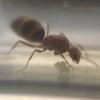I know these photo's aren't very good, but they are the best that I have at the moment. In the next few days i'll take her out of the platic tube I have her in and try to take some better photo's, but until then is it even possible to confirm that this is a queen?
She was caught in South Florida, on the east coast. I found her in a park that was in a scrub forest, just before noon on April 2nd. She is 1/2 inch in length, and appears to be a dark brown
I have done this catch and observe thing with a few ants, but this is the first one that just wanted to be out of the light, and didn't really try to escape.




Thanks ahead of time for your reply.
Edited by Shifty189, April 2 2018 - 4:57 PM.





















